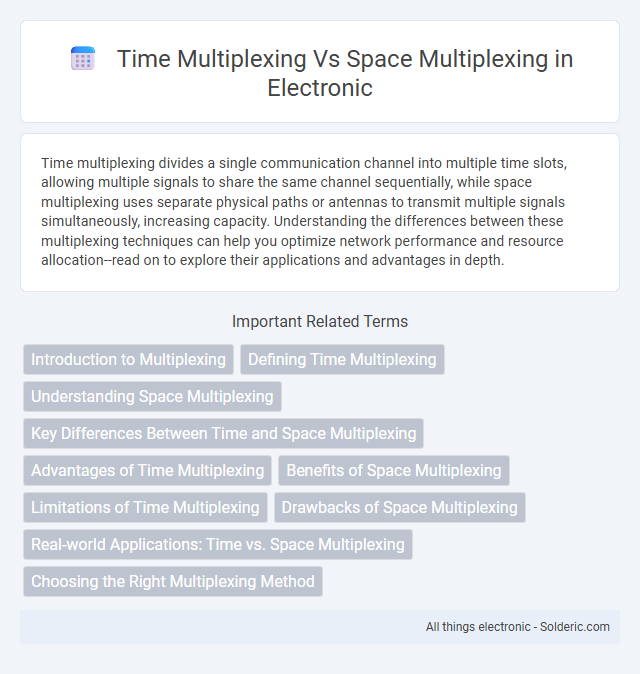Time multiplexing divides a single communication channel into multiple time slots, allowing multiple signals to share the same channel sequentially, while space multiplexing uses separate physical paths or antennas to transmit multiple signals simultaneously, increasing capacity. Understanding the differences between these multiplexing techniques can help you optimize network performance and resource allocation--read on to explore their applications and advantages in depth.
Comparison Table
| Aspect | Time Multiplexing | Space Multiplexing |
|---|---|---|
| Definition | Sharing a single resource by allocating time slots to multiple signals | Using multiple physical channels or paths simultaneously for signal transmission |
| Key Example | Time Division Multiplexing (TDM) | Frequency Division Multiplexing (FDM), Spatial MIMO |
| Resource Utilization | Single resource divided by time | Multiple resources divided by space/location |
| Bandwidth Efficiency | Efficient for low-latency, time-sequenced data | High capacity exploiting simultaneous spatial channels |
| Complexity | Requires synchronization and timing control | Requires multiple physical paths and spatial separation |
| Latency | Potential delay due to time slot allocation | Lower latency due to parallel transmission |
| Application | Telephone networks, digital signal transmission | Wireless MIMO systems, fiber optic multiplexing |
Introduction to Multiplexing
Multiplexing is a critical technique in communication systems that allows multiple signals to share a single transmission medium efficiently. Time multiplexing divides the medium into time slots, assigning each signal a unique interval for transmission, optimizing bandwidth utilization by alternating transmissions over time. Space multiplexing separates signals by physical channels or paths, enabling simultaneous data streams without interference by using different spatial locations or antennas.
Defining Time Multiplexing
Time multiplexing divides a single communication channel into multiple time slots, allowing several signals to share the same transmission medium sequentially. This method increases efficiency by allocating specific time intervals for each data stream, minimizing interference and maximizing bandwidth usage. Understanding time multiplexing helps you optimize network performance by ensuring timely and organized data transmission.
Understanding Space Multiplexing
Space multiplexing involves allocating multiple spatial channels or paths simultaneously to transmit different data streams, effectively increasing network capacity without requiring additional time slots. This technique leverages multiple input and output antennas (MIMO) or separate physical paths to enhance throughput and reduce interference in wireless and optical communication systems. Space multiplexing is crucial for improving spectral efficiency and meeting high-demand bandwidth requirements in modern telecommunication networks.
Key Differences Between Time and Space Multiplexing
Time multiplexing transmits multiple signals over a single channel by allocating distinct time slots to each signal, optimizing bandwidth usage. Space multiplexing, on the other hand, utilizes separate physical channels or spatial paths to transmit multiple signals simultaneously, enhancing data throughput and reducing interference. The primary difference lies in time-multiplexing's focus on temporal separation versus space-multiplexing's reliance on spatial separation for signal transmission.
Advantages of Time Multiplexing
Time multiplexing allows multiple signals to share the same transmission medium by allocating separate time slots, making efficient use of bandwidth and reducing hardware costs. It supports dynamic bandwidth allocation, improving flexibility and scalability in communication systems. Your network can benefit from enhanced synchronization and simpler multiplexing hardware compared to space multiplexing approaches.
Benefits of Space Multiplexing
Space multiplexing significantly enhances network capacity by transmitting multiple signals simultaneously over separate spatial channels, reducing latency and increasing throughput. It optimizes resource allocation in multi-antenna systems like MIMO, enabling higher spectral efficiency and improved signal reliability. This method supports scalable and flexible communication systems, essential for advanced wireless technologies such as 5G and beyond.
Limitations of Time Multiplexing
Time multiplexing faces limitations such as increased latency and reduced data throughput when handling multiple signals sequentially on a single channel. The technique is constrained by the switching speed of the time division multiplexing (TDM) hardware, which can cause timing synchronization issues and signal degradation. Bandwidth allocation inefficiencies also occur, especially in bursty traffic scenarios, leading to underutilization of the communication channel.
Drawbacks of Space Multiplexing
Space multiplexing, while advantageous in increasing capacity by utilizing parallel spatial channels, faces significant drawbacks such as high hardware complexity and increased power consumption. The requirement for multiple antennas and intricate signal processing can lead to higher costs and physical design challenges. Your system may also encounter limitations in scalability and interference management when deploying extensive space multiplexing configurations.
Real-world Applications: Time vs. Space Multiplexing
Time multiplexing is widely used in telecommunications, enabling multiple users to share the same frequency channel by assigning different time slots, as seen in Time Division Multiple Access (TDMA) systems. Space multiplexing is prominent in wireless communications with technologies like Multiple Input Multiple Output (MIMO), where multiple antennas transmit parallel data streams to increase capacity and spectral efficiency. In optical networks, space multiplexing supports high-capacity data transmission through multicore or multimode fibers, while time multiplexing is essential for scheduling data packets in network routers and switches.
Choosing the Right Multiplexing Method
Choosing the right multiplexing method depends on your system's bandwidth requirements and available resources. Time multiplexing suits scenarios where a single channel shares multiple signals sequentially, maximizing efficiency in limited bandwidth environments. Space multiplexing works best when separate physical channels are available, allowing simultaneous transmission and greater overall data throughput.
time multiplexing vs space multiplexing Infographic

 solderic.com
solderic.com